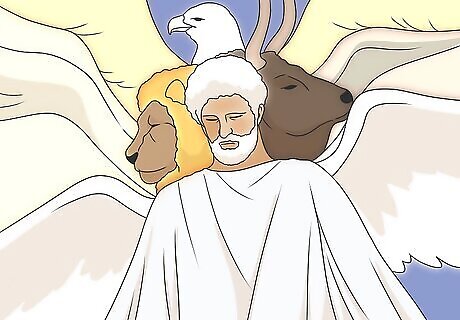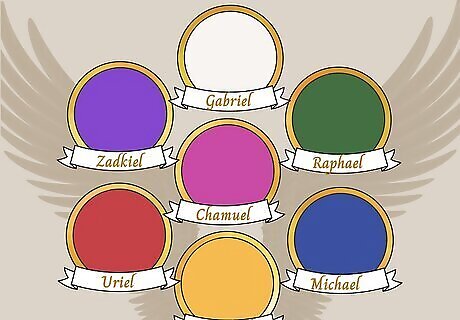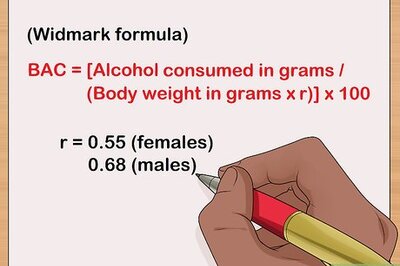
views
- Angels in the bible have varying, otherworldly, and often shocking appearances. For example, Ophanim angels appear to be interconnecting wheels lined with eyes.
- Cherubim (cherubs) are angels with 4 faces. In Ezekiel, a cherub is depicted with 4 wings and the face of a man, ox, lion, and eagle.
- Malakim (messenger angels like the archangels Michael and Gabriel) are described as more human-like than other angels, appearing as clothed men.
Biblical Descriptions of Angels

There are 4 main types of biblical angel, and their appearances vary. These angels include cherubim (cherubs), seraphim (seraphs), ophanim, and malakim—each with their own purpose, duty, and distinct description. Malakim are thought to look nearly human, while the others are more alien and otherworldly, from the cherubim’s animalistic features to the seraphim's multiple pairs of wings and the ophanim's strange, wheeled bodies.

Cherubim are often described as angels with 4 faces. In Western media, cherubim (cherubs) are depicted as baby-like creatures with halos. However, in the Bible, cherubim have 4 faces (the faces of an ox, a lion, an eagle, and a man) and 4 sets of wings. They also wielded flaming swords while fulfilling their duties, watching over the Garden of Eden. Ezekiel 1:5-6: “Also out of the midst thereof came the likeness of four living creatures. And this was their appearance; they had the likeness of a man. And every one had four faces, and every one had four wings.” Ezekiel 1:8-9: “And they had the hands of a man under their wings on their four sides; and they four had their faces and their wings. Their wings were joined one to another; they turned not when they went; they went every one straight forward.” Ezekiel 1:10: “As for the likeness of their faces, they four had the face of a man, and the face of a lion, on the right side: and they four had the face of an ox on the left side; they four also had the face of an eagle.” Genesis 3:24: “After he drove the man out, he placed on the east side of the Garden of Eden cherubim and a flaming sword flashing back and forth to guard the way to the tree of life.”

Seraphim appear as beings with 6 wings. Each pair of wings has a different function, with two covering their faces, two covering their legs, and two used to fly. Seraphim angels surround the throne of God and sing in unison as God draws near, according to the prophet Isaiah, with their faces (and eyes) supposedly hidden so they can’t stare directly at God. Verses featuring seraphs include: Isaiah 6:2: “Above Him were seraphs, each with six wings: With two wings they covered their faces, with two they covered their feet, and with two they were flying.” Isaiah 6:3-4: “And they were calling to one another: "Holy, holy, holy is the LORD Almighty; the whole earth is full of his glory. At the sound of their voices the doorposts and thresholds shook and the temple was filled with smoke.”

Ophanim are portrayed as wheels within wheels. Of all the different angels referenced in religious texts, ophanim are perhaps the most otherworldly. “Ophanim” is the ancient Hebrew word for “wheels,” which is why they’re described as being made from interconnecting wheels at right angles to one another, lined with many eyes. They float through the air, protecting God’s throne. Verses featuring ophanim include: Ezekiel 1:15-16: “As I looked at the living creatures, I saw a wheel on the ground beside each creature with its four faces. This was the appearance and structure of the wheels: They sparkled like topaz, and all four looked alike. Each appeared to be made like a wheel intersecting a wheel.” Ezekiel 1:17-18: “As they moved, they would go in any one of the four directions the creatures faced; the wheels did not change direction as the creatures went. Their rims were high and awesome, and all four rims were full of eyes all around.” While the Bible doesn’t explicitly name Ophanim as angels, Jewish apocalyptic writers do, mainly because they’re described as powerful beings that exist near the throne of God.

Some angels are completely invisible. Since angels are spiritual beings, they’re often hidden from the human eye or invisible as they go about their business, as is reflected in the story of Balaam (a biblical prophet) and his donkey. Balaam doesn’t see the angel at first, but his donkey does—and only when God opens his eyes does he see the angel nearby. Numbers 22:23: “When the donkey saw the angel of the Lord standing in the road with a drawn sword in his hand, it turned off the road into a field. Balaam beat it to get it back on the road.” Numbers 22:29-30: “Then the Lord opened the donkey's mouth, and it said to Balaam, ‘What have I done to you to make you beat me these three times?’ Balaam answered the donkey, ‘You have made a fool of me! If only I had a sword in my hand, I would kill you right now.’” Numbers 22:32: “Then the Lord opened Balaam's eyes, and he saw the angel of the Lord standing in the road with his sword drawn. So he bowed low and fell facedown.”

Regardless of appearance, angels can be terrifying and awe-inspiring. There are multiple Bible verses in which angels say, “Do not be afraid” or “Fear not,” to the humans they appear to. This suggests that the angels’ sheer power and overwhelming presence can initially unnerve the people who see them. Luke 2:10-11: “An angel of the Lord appeared to them, and the glory of the Lord shone around them, and they were terrified. But the angel said to them, ‘Do not be afraid. I bring you good news that will cause great joy for all the people.’” Matthew 28:2-4: “There was a violent earthquake, for an angel of the Lord came down from heaven and, going to the tomb, rolled back the stone and sat on it. His appearance was like lightning, and his clothes were white as snow. The guards were so afraid of him that they shook and became like dead men.” However, angels are also thought to be incredibly beautiful because they’re always in the presence of God; thus, God’s glory is reflected in them (as mentioned in Luke 2).
Does the Bible depict angels in human form?

Angels called Malakim can take on the appearance of men. Malakim, or malachim, means “messengers” and “angels” in Hebrew. They’re depicted as messenger angels who spread God’s word; the archangels Michael, Gabriel, and Raphael are all malakim. In the Bible, malakim in their physical forms resemble male humans—and sometimes, the mortals who see them don’t immediately recognize them as angels. Mark 16:5: “As they entered the tomb, they saw a young man dressed in a white robe sitting on the right side, and they were alarmed.” Daniel 10:5-6: “I lifted up my eyes and looked, and behold, a man clothed in linen, with a belt of fine gold from Uphaz around his waist. His body was like beryl, his face like the appearance of lightning, his eyes like flaming torches, his arms and legs like the gleam of burnished bronze, and the sound of his words like the sound of a multitude.” Joshua 5:13: “Now when Joshua was near Jericho, he looked up and saw a man standing in front of him with a drawn sword in his hand. Joshua went up to him and asked, ‘Are you for us or for our enemies?’” Genesis 18:2: “Abraham looked up and saw three men standing nearby. When he saw them, he hurried from the entrance of his tent to meet them and bowed low to the ground.”

The Bible doesn’t describe humanoid angels as having wings. Although many famous works of medieval art portray angels as winged men, it’s actually unclear if biblical angels that took on a human-like appearance in visions actually had wings; their descriptions don’t mention wings of any kind. The only angelic creatures depicted with wings are cherubim and seraphim!

Angels are depicted as clothed and able to eat in human form. Whenever angels appear with human features, they’re also wearing clothes —often brightly-colored or white garments. They can also eat food, as described in Genesis (although, as spirits, it’s believed that angels don’t need to eat to survive the way humans do). For example: Genesis 18:8: “Then he took curds and milk and the calf that he had prepared, and set it before them; and he stood by them under the tree while they ate.” Luke 24:4: “While they were perplexed about this thing, suddenly two men in dazzling clothes stood beside them.” Acts 1:10: “They were looking intently up into the sky as He was going, when suddenly two men dressed in white stood beside them.”
What are angels in the Bible?

Angels are spirit beings that can adopt physical forms. Because they’re spirits, angels are believed to manifest in many different forms—to the extent that it’s difficult to say for sure what a biblically accurate angel looks like. Although the Bible contains a few descriptions, they’re vague enough that an angel’s true appearance can be interpreted in different ways. If nothing else, the Bible affirms that angels are mysterious, otherworldly, and awe-inspiring.

Angels are messengers and warriors who spread God’s word. According to the Bible, angels are servants of God who often deliver messages to humans. They tend to appear and speak to people when God has an important lesson to convey or news to share—although, as warriors, they also issue warnings and carry out God’s justice when commanded to. Luke 1:19: “The angel said to him, "I am Gabriel. I stand in the presence of God, and I have been sent to speak to you and to tell you this good news.” Hebrews 1:14: "Are not all angels ministering spirits sent to serve those who will inherit salvation?" Psalm 48:49: “He unleashed against them his hot anger, his wrath, indignation and hostility— a band of destroying angels."

Angels are protectors and guardians. Ever heard of a “guardian angel?” Many people who believe in angels take comfort in the thought that they’re watching over humanity. The idea that some angels serve as protectors is addressed in the Bible—in verses from Exodus and Genesis, for example. Exodus 14:19-20: “Then the angel of God, who had been traveling in front of Israel's army, withdrew and went behind them. The pillar of cloud also moved from in front and stood behind them, coming between the armies of Egypt and Israel.” Genesis 48:16: “The Angel who has delivered me from all harm—may he bless these boys. May they be called by my name and the names of my fathers Abraham and Isaac, and may they increase greatly on the earth."

Angels direct all praise and worship to God. Throughout the Bible, angels are always depicted as humble, loyal beings. In any biblical story in which someone sees an angel and starts to worship them, the angel instead tells them to give that praise to God—despite the fact that they’re portrayed as majestic beings with a striking, commanding appearance.
What color are angels?

Seven notable archangels are associated with specific colors. The majority of angels don't have any sort of set color or color palette in the Bible or other religious texts. However, it’s believed that the 7 archangels are each represented by a different color (or light ray)— and that seeing an “angel color” can connect you to each angel more deeply. White represents the archangel Gabriel. Green represents the archangel Raphael. Blue represents the archangel Michael. Yellow represents the archangel Jophiel. Red represents the archangel Uriel. Purple represents the archangel Zadkiel. Pink represents the archangel Chamuel.
















Comments
0 comment